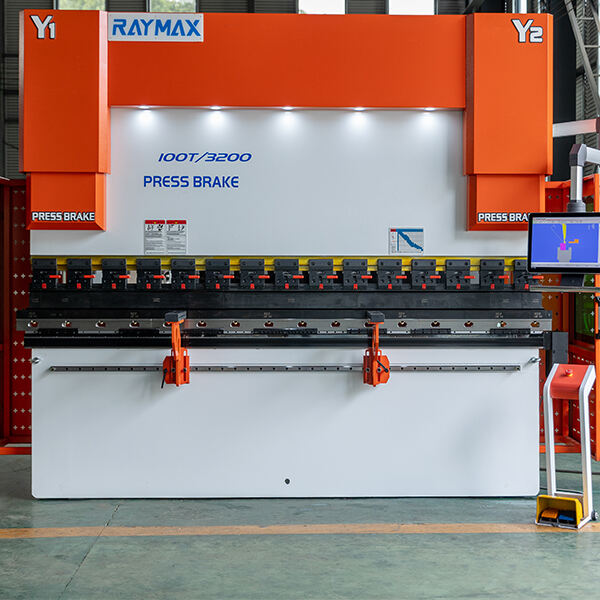현대 제조업에서 프레스 브레이크 설계의 발전
수동 방식에서 CNC 기반 시스템으로
수동 방식의 프레스 브레이크에서 CNC 제어 방식으로의 전환은 제조 분야에서 중대한 발전을 의미한다. 초기에는 수동 프레스 브레이크를 작동하기 위해 많은 인적 노력과 숙련도가 필요했기 때문에 작업 정밀도에 큰 차이가 있었다. 그러나 오늘날 CNC 프레스 브레이크의 등장으로 훨씬 정확하고 효율적인 공정이 가능해졌다. CNC 기술 덕분에 작업자는 복잡한 교육을 받지 않아도 되며, 대신 프로그래밍된 컴퓨터 시스템을 사용하여 복잡한 벤딩 작업을 수행할 수 있다. 관련 자료에 따르면 다른 통계에서도 현재 공정의 생산 시간과 노동 비용이 크게 절감된 것으로 나타났다. 예를 들어, CNC 프레스 브레이크 사용을 기반으로 한 연구에 따르면 퍼센트 채택률에 따라 제조 효율성이 50% 증가한 것으로 나타났다.
CNC가 작동하는 소프트웨어도 현대 시스템에서 발전해 왔습니다. 다축 제어 프로그래밍 혁신 도입을 통해 정밀한 디테일 작업을 제조할 수 있는 능력을 확보하게 되었으며, 이러한 발전은 사용자 인터페이스의 복잡성을 줄이고 운용 유연성을 높여 제조 요구사항의 변화에 보다 쉽게 대응할 수 있게 합니다. 이들 시스템은 초보자라도 고급 제조 장비를 다루는 데 어려움 없이 빠르게 익힐 수 있도록 사용 편의성에 중점을 두고 설계되었습니다.
경량 소재 및 인체공학적 기능
프레스 브레이크 설계에 경량 소재를 사용함으로써 제작 공장의 작업장에서 손쉽게 이동시키고 효율적으로 활용할 수 있습니다. 요즘 현대적인 프레스 브레이크는 고강도 알루미늄 및 복합 소재로 제작되어 기계 자체가 일반적으로 가벼워 운송 및 설치가 보다 용이해졌습니다. 이러한 발전은 다운타임을 획기적으로 줄여 생산 현장의 효율성을 상당히 높이는 결과로 이어졌습니다.
소재 개선 외에도 운전자의 안전과 편안함을 위한 인체공학적 개선에 중점을 두었습니다. 인체공학적 컨트롤 장치와 프레스 브레이크의 조절 가능한 부품은 작업자에게 가해지는 신체적 부담을 줄여주며 부상에 대한 염려 없이 보다 효율적인 속도로 작업할 수 있게 합니다. 사무실 인체공학에 관한 설문조사에 따르면 이러한 설계 변경을 통해 작업장 피로와 피로로 인한 실수를 줄임으로써 생산성이 향상되었다고 합니다. 이러한 발전은 운전자가 친화적인 현대 기계에 적용되어 다양한 산업 분야에서 활용할 수 있는 기능을 제공합니다.
프레스 브레이크 기능에 적용된 CNC 기술 통합
자동화 백게이지(Backgauges)를 통한 정밀 제어
CNC 프레스 브레이크는 프레스 브레이크 기술 중 가장 최첨단 기술입니다. CNC(수치제어장치)가 장착되어 있으며, 벤딩 구조를 완전히 제어할 수 있어 프로파일 벤딩에 있어 가장 고도화되고 정밀한 장비입니다. 완전히 조정 가능한 범위를 갖추고 있어 측정 오류를 줄이며 이상적인 측정값에 도달하도록 설정할 수 있으며, 생산의 모든 단계에서 높은 수준의 정확도를 유지합니다. 예를 들어, 제작자들은 벤딩 반복 정확도가 획기적으로 향상되었으며, 세팅 간 일치도가 수동 작업 절차에 비해 훨씬 우수하다고 말합니다. 고객 사례에서는 자동화 기술의 신뢰성을 언급하며, 세팅 시간과 소재 측면에서 상당한 절감 효과를 얻었다고 설명합니다. 또한 센서 기술의 발전은 백게이지 포지셔닝의 정확도를 한층 더 향상시켜 작업자에게 실시간 피드백을 제공하고, 이를 통해 작업 단계를 최적화할 수 있게 해줍니다. 이러한 기술 통합은 작업 효율성을 극대화할 뿐만 아니라, 오늘날 세계적으로 요구되는 복잡한 제조 수요에도 잘 대응할 수 있습니다. 인간의 실수 가능성이 줄어들고 효율성이 향상됨에 따라, 자동 백게이지의 역할은 금속판금 제작 발전에 있어 점점 더 핵심적인 위치를 차지하게 되고 있습니다.
복합 형상용 적응형 벤딩 기술
CNC를 통한 적응 굽힘 기술은 프레스 브레이크 굽힘 공정에서도 발전하였으며, 매우 높은 정밀도로 복잡한 부품들을 제작할 수 있게 되었습니다. 자동차 및 항공우주 산업과 같은 분야는 제품에 있어 핵심적인 역할을 하는 복잡한 부품 제조에 이러한 고도의 굽힘 기술에 의존하고 있습니다. 예를 들어, 항공 산업에서는 CNC 제어 프레스 브레이크를 사용하여 항공기 설계에 필요한 복잡하고 정밀한 각도와 형태의 부품들을 생산합니다. 본문에서는 주요 튜브 굽힘 기계에 대한 고객 사례 연구를 통해 CNC 시스템이 다양한 복잡한 형태에 어떻게 쉽게 대응할 수 있는지 보여주고 있으며, 이들이 다양한 산업 분야에서 보편적으로 호환된다는 사실을 입증하고 있습니다. 소프트웨어 도구는 이러한 측면에서 핵심적인 역할을 하며, 작업자들이 복잡한 형상을 효율적으로 설계하고 프로그래밍할 수 가능하게 합니다. 이러한 소프트웨어는 복잡한 굽힘 순서를 시각화하고 수정할 수 있는 사용자 친화적인 환경을 제공함으로써 복잡한 작업 수행 능력을 크게 향상시킵니다. 이러한 CNC 기술은 설계 분야를 확장할 뿐만 아니라 생산을 촉진하므로, 적응 굽힘이 시트메탈 가공에서 필수적인 기능이라 말할 수 있습니다.
유압 프레스 브레이크 성능 개선
에너지 효율 펌프 시스템
유압 펌프 구동 시스템의 도입은 프레스 브레이크가 덜 에너지를 소비하도록 하여 비용 절감과 친환경 솔루션을 가능하게 했습니다. 오늘날 산업계에서는 유압 시스템을 실제로 가능한 한 에너지 효율적으로 만들기 위한 최신 규격과 측정 기준을 도입하고 있습니다. 이는 단순히 운영 비용이 저렴한 것을 넘어 친환경적이라는 장점도 가지고 있습니다. 예를 들어, 유압 프레스 브레이크용 VSD 펌프 시스템은 에너지의 50%를 절약할 수 있어 소비가 극히 적습니다. 이러한 에너지 효율 시스템으로의 전환은 제조업체가 전기 요금을 절감하고 보다 엄격한 환경 규제를 준수할 수 있도록 해주기 때문에 매우 중요합니다.
에너지 절약형 유압 시스템은 직접적 및 간접적인 효과 덕분에 상당한 환경적 가치를 가지고 있습니다. 이러한 시스템은 에너지를 직접적으로 절약할 뿐만 아니라 온실가스(GHG) 배출량이 적어 간접적으로도 긍정적인 영향을 미칩니다. 또한 상당한 비용 절감 효과 역시 중요한 고려 사항입니다. 에너지 절약형 펌프로 전환한 기업들은 이미 운영 비용에서 큰 절감 효과를 얻고 있으며, 이는 곧 빠른 투자 회수를 의미합니다. 대표적인 예로는 서보 유압 펌프 시스템을 적용한 프레스 브레이크가 있으며, 이는 현대 생산 환경에서 높은 효율성을 제공합니다.
스마트 안전 기능 및 하중 모니터링
유압 프레스 브레이크에 부하 모니터링 시스템과 같은 '스마트' 안전 기능을 결합하는 것은 프레스 과부하로부터 보호하고 작업자 안전을 유지하는 데 있어 또 다른 중대한 발전입니다. 오늘날의 현대적인 프레스 브레이크에는 작업 조건을 지속적으로 점검하여 안전한 작업이 이루어지도록 조정하는 스마트 시스템이 장착되고 있습니다. 이러한 발명은 사고를 줄이고 장비를 보호하여 작업 환경을 더욱 안전하게 만들어 줍니다. 반면에 스마트 안전 기능을 도입한 공장의 사례 연구에 따르면 유지보수 문제 발생이 30% 감소했으며, 기계 오류 역시 줄어든 것으로 보고되었습니다.
공장 수준의 안전 문제는 엄격한 규정의 적용 대상이며, 바로 이러한 혁신적인 솔루션이 두드러진 성과를 발휘하는 분야입니다. 제조업체의 경우 이러한 규정을 준수하는 것이 매우 중요하며, 스마트 안전 시스템을 도입하면 규정 준수를 위한 이상적인 방법을 제공합니다. 프레스 브레이크에 최신 하중 모니터링 기능이 통합됨으로써 기업은 직업 안전 규정을 훨씬 효과적으로 준수할 수 있을 뿐만 아니라, 최고 수준의 경영 목표 달성에도 유리한 위치를 차지하게 됩니다. 또한 이러한 안전 기능 통합은 공장 및 산업 시설에 더 높은 생산성과 안전성을 제공하는, 상호 연결된 더 스마트한 기계로의 산업 전반의 변화를 반영하고 있습니다.
프레스 브레이크 설치의 운영 개선
터치스크린 인터페이스 간소화
터치스크린이 있는 제어 패널은 세팅 시간을 단축시키고 사용 용이성을 최적화함으로써 프레스 브레이크의 설정 방식을 혁신적으로 바꾸어 놓았습니다. 작업자들의 피드백에 따르면, 터치스크린 제어 방식은 기존의 수동 입력 방식보다 훨씬 직관적이고 조작이 용이합니다. 특히 프레스 브레이크가 세팅 과정에서 실시간 그래픽 지원을 제공함에 따라 작업자들의 만족도가 점점 더 높아지고 있습니다. 이러한 기술 발전은 신규 작업자가 적응하는 데 필요한 학습 곡선을 크게 단축시켰으며, 업계 통계에 따르면 교육 시간이 최대 30%까지 줄어들어 제조업체가 효율성을 높이고 다운타임을 최소화할 수 있도록 도와주고 있습니다.
클라우드 기반 프리셋 공유 기능
클라우드 기반의 프리셋 공유를 통해 기계에 대한 프리셋 자동 업로드/다운로드가 가능해져 생산성을 향상시킵니다. 이러한 기술은 수동 데이터를 통한 복사/설정을 불필요하게 하며, 작업자가 신속하게 최적의 설정을 적용할 수 있도록 해주어 기계 정지 시간을 획기적으로 줄일 수 있습니다. 예를 들어, 동일한 파일이 여러 프레스 브레이크에서 생산되는 경우, 검증된 프리셋을 클라우드 기능을 통해 공유할 수 있습니다. 하지만 클라우드 기술의 전면적인 도입에는 정당한 우려가 존재합니다. 제조업체들은 암호화 및 다중 인증 정책을 포함한 강력한 사이버보안 방식을 도입함으로써 중요한 데이터를 보호하고 안전하게 운영하려 하고 있습니다.
판금 가공의 특수 응용 분야
중량 작업용 고톤수 기계
금속 가공에서 두꺼운 강판 및 알루미늄 작업과 같은 중하중 벤딩 작업 및 기계 공학 분야의 고속 생산에 적합합니다. 이는 실용적이고 고품질의 로즈 엔진 선반으로, 가장 까다로운 작업에도 견딜 수 있도록 튼튼하게 제작된 견고한 중형 기계입니다. 이러한 기계들은 필요에 따라 무거운 금속 부품을 자유자재로 가공할 수 있는 파워와 정교함을 제공합니다. 성능 벤치마크는 중공업 제작 시장에 제공되는 이러한 기계들의 가치를 입증하며, 기계 프레임 및 구조 부품 제작과 같은 제품 생산에서는 신뢰성과 파워가 필수적인 요소입니다.
일련의 기술적 개선 덕분에 고톤수 프레스 브레이크는 이전보다 훨씬 더 정확해졌으며, 특히 중량 부하 하에서 그러합니다. 최신 기술로는 우수한 유압 시스템과 CNC 통합 기술이 포함되며, 이는 정밀도를 크게 향상시키고 대형 재료를 취급할 때 발생할 수 있는 오류를 제거하였습니다. 이러한 진화를 통해 PP사는 복잡한 부품에서도 보다 많은 벤딩 작업을 고품질로 수행할 수 있게 되었으며, 이는 중두량 금속 가공 분야에서 요구하는 보다 빠르고 정확한 벤딩 작업 수요를 충족하고 있습니다.
정밀 부품을 위한 마이크로 벤딩 기술
구부러지지 않고 휘는 얇은 금속을 포함한 전자제품이나 의료기기와 같은 취성 부품을 제작하는 것은 복잡할 수 있지만, 마이크로 벤딩 기술은 제작 공정을 상당히 단순화시켰다. 이는 얇고 유연한 소재의 보존이 무엇보다 중요한 산업 분야에 전례 없는 가능성을 열어주었다. 예를 들어 회로 기판이 매우 작고 짧아서 손상을 입지 않도록 정밀하게 굽힘 가공이 필요한 전자 산업 분야가 있다.
그러나 상기 미세 굽힘 기술은 또한 결함이 있습니다. 소재 손상이 크게 발생하며, 정밀한 정렬과 제어를 위해 고급 장비와 숙련된 기술자가 필요합니다. 해결 방법으로는 맞춤형 공구 및 제어 장치를 사용하여 균일한 결과를 유지하는 방안이 있습니다. 고정밀 굽힘에 대한 수요가 증가함에 따라 미세 굽힘 기술도 발전해 왔지만, 이는 여전히 많은 기업들이 개선을 위해 노력하고 있는 공정이며, 현대의 금속판 가공 기술의 핵심이 되어 왔습니다. 미세 굽힘 기술은 제조 분야에서의 효율성과 품질 향상 측면에서 여전히 발전 가능성이 큽니다.



